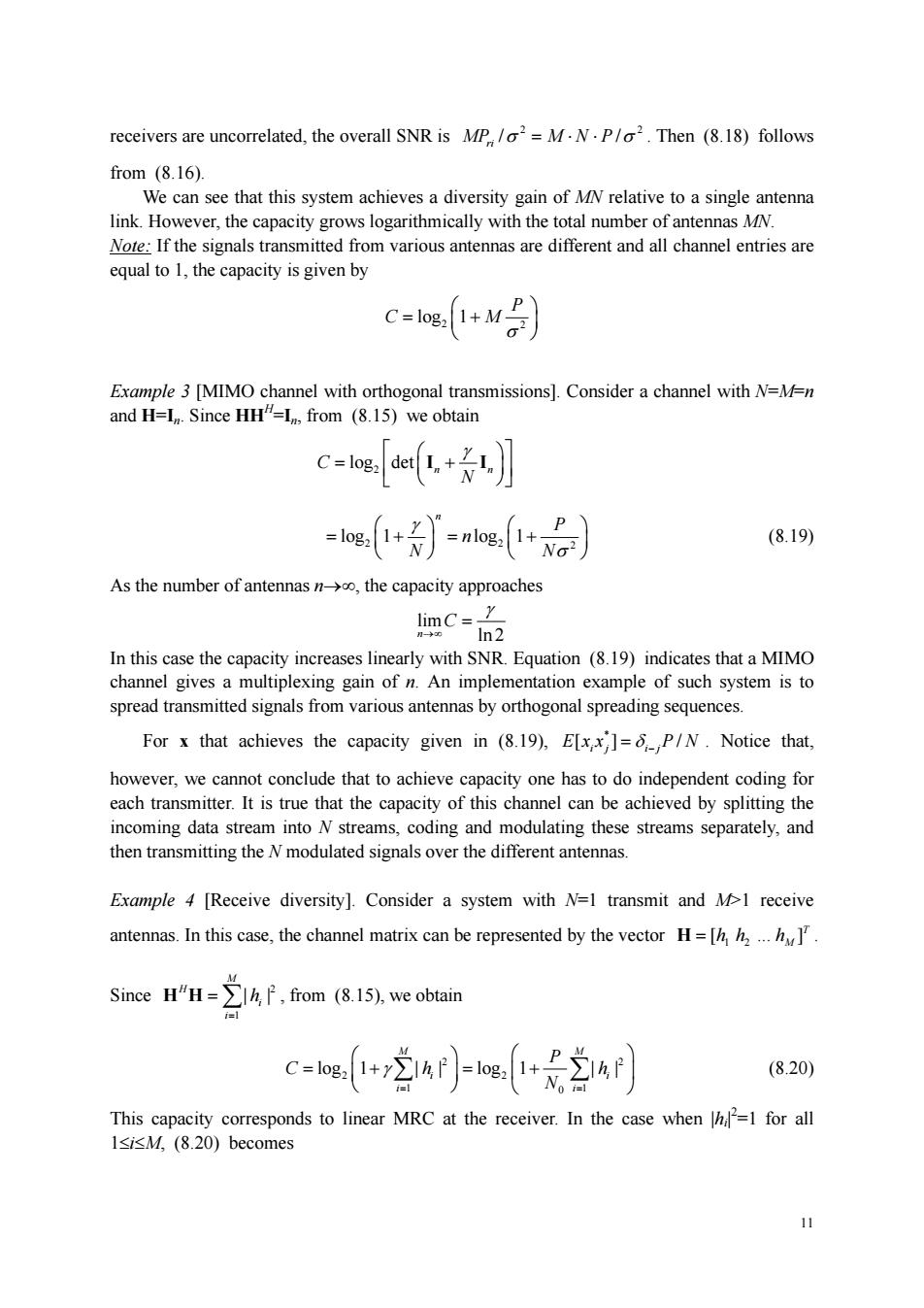正在加载图片...

receivers are uncorrelated,the overall SNR is MP/2=M.N.P/2.Then (8.18)follows Wecan see that this system achieves a diversity gain of relative to a single antenna link.However,the capacity grows logarithmically with the total number of antennas MN. Note:If the signals transmitted from various antennas are different and all channel entries are equal to 1,the capacity is given by .) Example 3 [MIMO channel with orthogonal transmissions].Consider a channel with N=M=n and H=I.Since HH"=I.from (8.15)we obtain C=log:detI+ -los,)log.) (8.19) As the number of antennas,the capacity approaches mc=品 In this case the capacity increases linearly with SNR.Equation(819)indicates that a MIMO nel gives a ofAn implem ple of such system is to spread transmitted signals from various antennas by orthogonal spreading sequences. For x that achieves the capacity given in (8.19),E[x=P/N.Notice that, however,we cannot conclude that to achieve capacity one has to do independent coding for each transmitter.It is true that the capacity of this channel can be achieved by splitting the incoming data stream into N、 streams,coding and odulating these streams separately,and then transmitting the N modulated signals over the different antennas Example 4 [Receive diversity].Consider a system with N=l transmit and M1 receive antennas.In this case,the channel matrix can be represented by the vector H=[ SinceH"H=,from (8.15),we obtain C-lo.)0g. (8.20) This capacity corresponds to linear MRC at the receiver.In the case when1for all 1≤iM,(8.20)becomes 11 11 receivers are uncorrelated, the overall SNR is 2 2 / / MP M N P ri . Then (8.18) follows from (8.16). We can see that this system achieves a diversity gain of MN relative to a single antenna link. However, the capacity grows logarithmically with the total number of antennas MN. Note: If the signals transmitted from various antennas are different and all channel entries are equal to 1, the capacity is given by 2 2 log 1 P C M Example 3 [MIMO channel with orthogonal transmissions]. Consider a channel with N=M=n and H=In. Since HHH=In, from (8.15) we obtain 2 log det C n n N I I 2 2 2 log 1 log 1 n P n N N (8.19) As the number of antennas n, the capacity approaches limn ln 2 C In this case the capacity increases linearly with SNR. Equation (8.19) indicates that a MIMO channel gives a multiplexing gain of n. An implementation example of such system is to spread transmitted signals from various antennas by orthogonal spreading sequences. For x that achieves the capacity given in (8.19), * [] / E i j ij xx P N . Notice that, however, we cannot conclude that to achieve capacity one has to do independent coding for each transmitter. It is true that the capacity of this channel can be achieved by splitting the incoming data stream into N streams, coding and modulating these streams separately, and then transmitting the N modulated signals over the different antennas. Example 4 [Receive diversity]. Consider a system with N=1 transmit and M>1 receive antennas. In this case, the channel matrix can be represented by the vector 1 2 [ . ]T M H hh h . Since 2 1 | | M H i i h H H , from (8.15), we obtain 2 2 2 2 1 1 0 log 1 | | log 1 | | M M i i i i P Ch h N (8.20) This capacity corresponds to linear MRC at the receiver. In the case when |hi| 2 =1 for all 1iM, (8.20) becomes